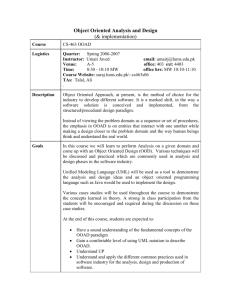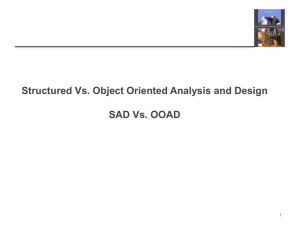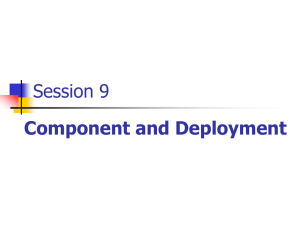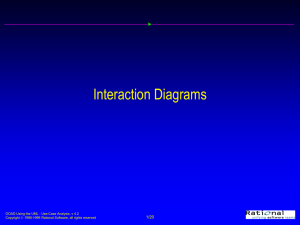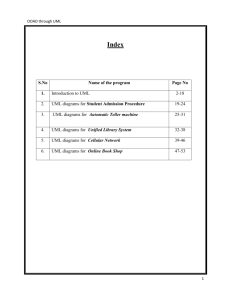INFO 638 - Software Project Management
advertisement
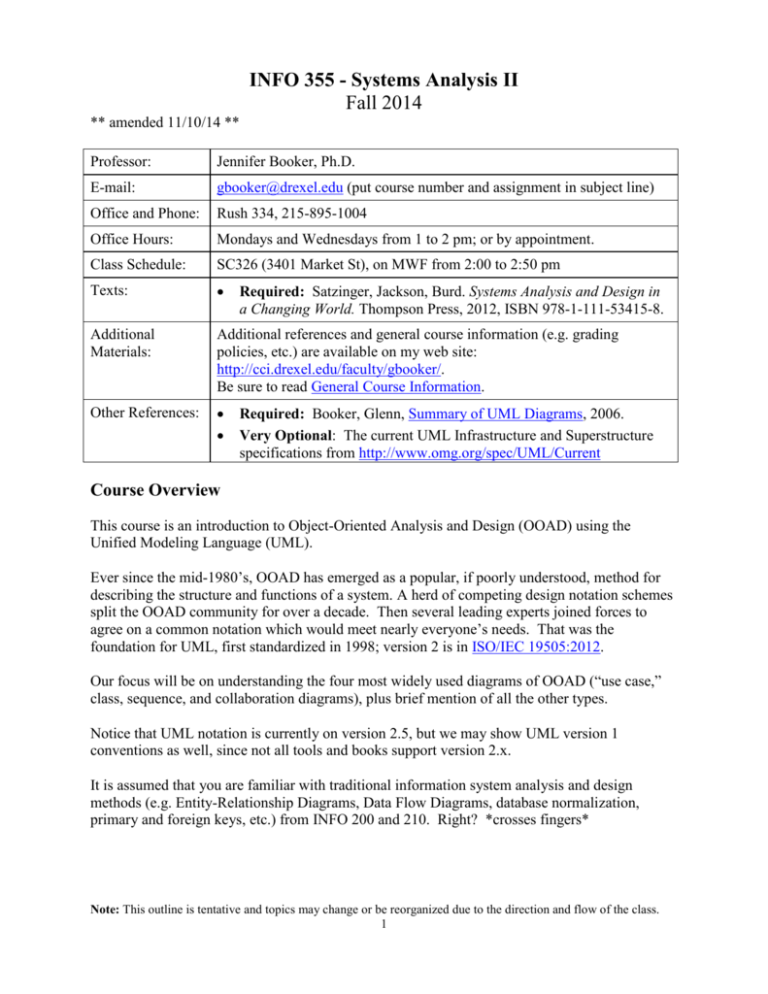
INFO 355 - Systems Analysis II Fall 2014 ** amended 11/10/14 ** Professor: Jennifer Booker, Ph.D. E-mail: gbooker@drexel.edu (put course number and assignment in subject line) Office and Phone: Rush 334, 215-895-1004 Office Hours: Mondays and Wednesdays from 1 to 2 pm; or by appointment. Class Schedule: SC326 (3401 Market St), on MWF from 2:00 to 2:50 pm Texts: Additional Materials: Additional references and general course information (e.g. grading policies, etc.) are available on my web site: http://cci.drexel.edu/faculty/gbooker/. Be sure to read General Course Information. Other References: Required: Satzinger, Jackson, Burd. Systems Analysis and Design in a Changing World. Thompson Press, 2012, ISBN 978-1-111-53415-8. Required: Booker, Glenn, Summary of UML Diagrams, 2006. Very Optional: The current UML Infrastructure and Superstructure specifications from http://www.omg.org/spec/UML/Current Course Overview This course is an introduction to Object-Oriented Analysis and Design (OOAD) using the Unified Modeling Language (UML). Ever since the mid-1980’s, OOAD has emerged as a popular, if poorly understood, method for describing the structure and functions of a system. A herd of competing design notation schemes split the OOAD community for over a decade. Then several leading experts joined forces to agree on a common notation which would meet nearly everyone’s needs. That was the foundation for UML, first standardized in 1998; version 2 is in ISO/IEC 19505:2012. Our focus will be on understanding the four most widely used diagrams of OOAD (“use case,” class, sequence, and collaboration diagrams), plus brief mention of all the other types. Notice that UML notation is currently on version 2.5, but we may show UML version 1 conventions as well, since not all tools and books support version 2.x. It is assumed that you are familiar with traditional information system analysis and design methods (e.g. Entity-Relationship Diagrams, Data Flow Diagrams, database normalization, primary and foreign keys, etc.) from INFO 200 and 210. Right? *crosses fingers* Note: This outline is tentative and topics may change or be reorganized due to the direction and flow of the class. 1 Course Outline Monday is Week Lecture Diagrams Topics Overview of systems analysis and design, System requirements 9/29/2014 Use cases 10/6/2014 Domain modeling No class on 10/13/14 (holiday) 10/13/2014 OO Design principles 1 1 9/22/2014 2 3 2 3 4 4 5 5 10/20/2014 6 6 10/27/2014 7 8 7 8 9 9 10 10 11 10 12/1/2014 Review All the above 12 - 12/8/2014 Finals week - OO Design use case realizations Quiz 1 No class on Friday Quiz 1 on Monday Essentials of design 11/3/2014 User and system interface design 11/10/2014 Extending requirements models Making the system operational 11/17/2014 Quiz 2 on Friday TBD 11/24/2014 No class on 11/26-28/14 (holiday) Activity Text Chapters 1, 2 Use case Domain Class 3 4 Design Class 10 Sequence Communication Package 11 - 6 State 7 5 - 13 - 1-7, 10, 11, 13 - Course Assessment The course has four homework assignments to help ensure you understand the principles which are being discussed, plus a Term Project to put them all together. All homework assignments are to be done individually. The Term Project may be done by 2-3 people (your choice). There will also be two quizzes, as noted earlier. Assignment 1 2 3 4 - Activity Use case modeling Class modeling Quiz 1 (covers weeks 1-4 topics) Sequence and class diagrams Term Project Proposal Sequence diagrams Quiz 2 (covers weeks 5-8 topics) Term Project Mutual Evaluation* Date Due Weighting 10/10/14 10% 10/17/14 10% 15% 10/27/14 10% 11/7/14 3% 11/10/14 10% 11/17/14 11/21/14 15% 12/10/14 27% 12/10/14 TOTAL 100% * Mutual Evaluation has no specific weighting, but can affect your Term Project grade. Note: This outline is tentative and topics may change or be reorganized due to the direction and flow of the class. 2 There is no final exam; the Term Project takes its place. Quizzes There will be two quizzes on the dates given. The quizzes will be closed book, and consist of about half multiple choice questions, and half application or short answer. Quiz contents will be based primarily on the lecture notes and the UML summary. A study guide will be provided. There will be no makeup quizzes, so make sure to be present! The quizzes are non-cumulative, and comprehensive, so prepare for them like a mid-term. Mutual Evaluation This form must be filled out by each group member to assess everyone’s participation in the group project – including your selves – and emailed to me. The mutual evaluation will be used to determine if different grades need to be assigned to each group member for the term project (instead of the default policy of everyone getting the same grade). Naturally, if you are doing a solo term project, the mutual evaluation is unnecessary. Software Tools This course will require that you generate diagrams using UML notation. It is assumed that the primary tool for doing so will be Microsoft Visio. You will get email from ‘DreamSpark Premium’ to get access to download Visio – do not delete this message! It is also acceptable to use any tool such as Rational Rose, OpenSelect, or SA/Object Architect, but those tools will not be discussed during the course. Participation Participation in class is not being graded; however you are responsible for the material covered in class. It is critical you attend classes due to the complexity of the course material. Participation in your term project is graded by the mutual evaluation, as described earlier. Your grade for the term project can be strongly affected by the results of the mutual evaluation, so keep that in mind during the term! Note: This outline is tentative and topics may change or be reorganized due to the direction and flow of the class. 3

